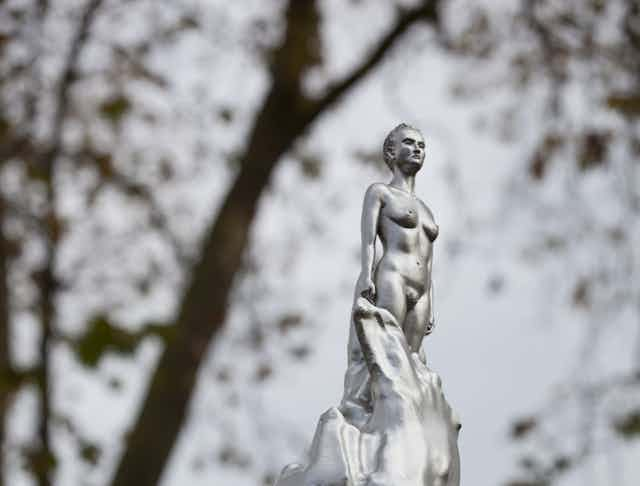A small naked female figure in silvered bronze emerges out of a swirling mass of organic matter. There is something excitingly unexpected about it all. Although not everyone shares this opinion of the recently unveiled memorial in north London to the feminist writer Mary Wollstonecraft (1759-1797) by the artist Maggi Hambling CBE.
The statue is a project ten years in the making – but centuries overdue. Wollstonecraft was one of the most defiant and intelligent voices in the period of our nation’s history which is often termed the Enlightenment (1715 – 1789). The arguments she advanced for women’s equality feel familiar today, but they were radical in her age.
Wollstonecraft paid a high personal cost for making her voice heard. Vilified in society as an adulteress and for conceiving a child out of wedlock, her unorthodoxy was condemned by the very society she worked to improve. But her political writings are extraordinary documents, including letters in close dialogue with the leading thinkers and events of the day.
Everywoman?
In her new monument, Hambling does not give us a figure of Wollstonecraft, but a vision of “everywoman”. The work feels more of an intervention in debates about monuments, than a monument for a specific person. The sculpture rejects a male tradition of public sculpture, in which the likeness of celebrated men is cast in bronze or carved in marble.
A statement on behalf of the campaign to raise the statue, which took a decade to source the necessary £143,300, described the work’s design:
As opposed to traditional male heroic statuary, the freestanding woman has evolved organically from, is supported by, and does not forget, all her predecessors who advocated, campaigned and sacrificed themselves for women’s emancipation.
Hambling should be praised for her attempt to break with this tradition but whether this statue is a fitting tribute to Wollstonecraft can be questioned.

Ultimately, statues don’t represent people, they represent ideas. Ideas of how we choose to see the world. Hambling’s more abstract and representative form perhaps tries to do too much: to celebrate the life and contribution of one woman, whilst celebrating the life and possibilities of all women.
Is such a feat even possible? In attempting to represent every woman, perhaps the statue stands testament to the impossibility of such a task.
The statue’s unveiling saw a swift response of female commentators who question the decision to present womankind, and Wollstonecraft’s contribution to our history, through an idealised naked form. Novelist Jojo Moyes said:
I think it would have been nice to commemorate Mary Wollstonecraft with her clothes on […] You don’t see a lot of statues commemorating male political figures without their pants on.
Fellow writer Imogen Hermes Gowar also rejected the “sexy toned female” figure, saying:
Nameless, nude and conventionally attractive is the only way women have ever been acceptable in public sculpture.
While such assessments misconstrue Hambling’s intention for her design, the statue is – in this early moment of its life – too provocative to please every woman. But then again, the same was true of Wollstonecraft’s own reception with her contemporaries.
Wollstonecraft’s portrait
It is impossible to know what Wollstonecraft would have made of the statue. She might have experienced sheer shock, perhaps, that the establishment would view her as a fitting subject for such a thing.

Hambling’s silvery creation is certainly a far cry from John Opie’s portrait of Wollstonecraft that hangs on the walls of the National Portrait Gallery in London.
A woman of elegant simplicity, you would barely believe you were looking at one of Britain’s most radical writers. Painted when Wollstonecraft was pregnant with her second daughter, Mary, the portrait is a poignant reminder of tragedy around the corner. Wollstonecraft died of septicaemia following the birth. Her daughter would grow up to become a formidable figure in her own right, writing her own monumental work, Frankenstein.
Wollstonecraft was not “every woman”. She was far more outspoken, more rebellious and braver than the average woman of her day. Upon her death, Wollstonecraft’s grieving husband, the author William Godwin, wrote to his friend, the writer Thomas Holcroft, that “there does not exist her equal in the world”. Hugely individual and brilliantly intellectual, Wollstonecraft was a rarity. It could be fair to say, then, that we are still in need of a statue to capture this.
Statues as history
Critics of Hambling’s monument should be reminded that this does not need to be our only statue for Wollstonecraft. True, it has been a long time coming. But Wollstonecraft is a shining beacon in British women’s history – a figure due many statues and acts of remembrance.
Hambling’s statue should remind us rather than distract from the fact that Wollstonecraft made her own final monument in the form of her writings. They are well worth reading.

So, too, are new statistics emerging from the nation’s newfound interest in its public sculpture. Women make up more than 50% of the UK’s population but are the subject of only 10% of the statues on London’s streets.
Whatever we may make of Hambling’s statue, today we have one more statue of, and for, women. It is a fact well worth celebrating.

